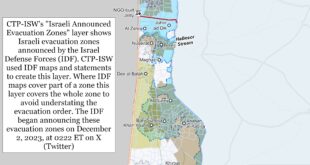
Once again it appears that pro-Iranian militias, such as the Fatimiyoun which are recruited from Afghan Shi’ites, were impacted by the airstrikes.
Airstrikes have targeted an area of “pro-Iranian militia” influence in the vicinity of Al-Bukamal on the Euphrates River in the Deir
ez-Zor Governorate of eastern Syria near the border with Iraq, the Syrian Observatory for Human Rights reported Saturday.
This area has often been targeted in the past by airstrikes. Syrian regime media has blamed Israel for these strikes in the past.
This follows other mysterious explosions on January 13 and 22, the report said. There were airstrikes near Al-Zamaliyah, southeast of Masyaf in Syria, according to reports on January 22. Syrian air-defense systems, firing wildly, apparently even shot a projectile that crashed in Jordan and one that fell on a civilian home.
The strikes took place at 4 a.m. and were carried out from aircraft over Tripoli in Lebanon, according to Syrian Arab News Agency, a regime-controlled news agency. The targets were near Hama.
The January 13 airstrikes hit Iranian militias in Syria near the Iraqi border. Those were considered the fourth similar airstrikes in
several weeks. Reports suggested at the time that US intelligence aided the strikes and that pro-Iranian militias might relocate to
Iraq due to the beating they were receiving.
Once again it appears that pro-Iranian militias, such as the Fatimiyoun, which are recruited from Afghan Shi’ites, were impacted.
These groups are part of Iranian networks from the Iraqi border to Deir ez-Zur along the Euphrates.
The airstrikes on January 30, 22 and 13 appear to be part of a pattern that has emerged over the years. While some Syrian sources blame Israel, Iran tends to remain quiet about what is happening in Syria.
Israel has in the past said Iran must end its entrenchment in Syria. Tehran has had some 1,000 Islamic Revolutionary Guard Corps
personnel in Syria in the past, but this number may now be slightly less. It now has tens of thousands of militia members there.
Iran also has trafficked precision munitions, drones, air defense, missiles and other weapons to Syria. Tehran sends some of these
munitions to Hezbollah. It also seeks to warehouse weapons and manufacture them.
In January 2019, the IDF chief of staff said Israel had carried out 1,000 airstrikes on Iranian targets in Syria. Since then, other
operations have been mentioned, such as in August and on November 17 last year.
Israel was stepping up airstrikes in January, according to FDD’s Long War Journal, an American news website that reports on the war on terrorism. Syrians reported a family had been harmed during the January 22 airstrikes near Hama. There were dozens of airstrikes in Syria in 2020, the IDF annual report for 2020 noted.
There are also tensions near the Golan Heights between the Syrian regime and former Syrian rebels. Reports of clashes over the weekend form part of a larger series of clashes last September and November. It now appears Dara’a and areas near the Golan are suffering a crackdown by Syrian regime forces.
However, the complex area with many demobilized Syrian rebels, who were recruited into the Russian-backed 5th Corps, continues to cause problems for Damascus.
 Eurasia Press & News
Eurasia Press & News



